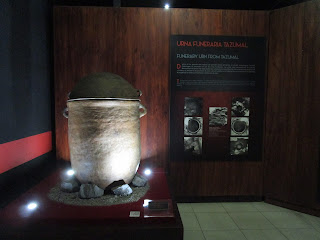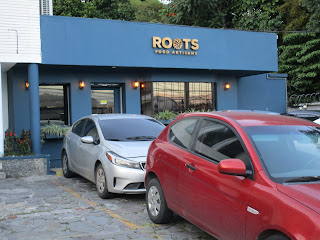 |
An illustration depicting anthropophagy in ancient tribes.
What's anthropophagy? Read on. |
First full day in my 40th country visited. My mood for the day could be best described by those mellow rockers, the Eagles, when they were standing on a corner in Winslow, Arizona, with such a fine sight to see: Take it easy.
It was only a five-hour flight, non-stop, Las Vegas to San Salvador, but first day of a vacation, even in a mini-vacation such as this, requires taking it easy on Day One because (a) while the travel isn't that stressful when it's a five-hour nonstop, even if the seats on the Avianca flight did not recline, prepping for travel is stressful, and (b) I'm old. And don't forget (c): San Salvador is much hillier than it appears to be on google maps. On google maps, the city looks like it would be relatively flat. And while there are hillier cities, this is a hilly city. So two museums is all the touristing I can take for Day One.
This is my hotel for the next five days: the Barceló San Salvador. The neighborhood is upscale:
Modern architecture surrounds me.
As does greenery, befitting a hot, humid city in the tropical latitudes during wet season.
Since we are in the upscale side of town, west of the Centro Historico, the city's major museums are a close walk. And soon we reach the first of the day's two museums: the David J. Guzman National Museum.
Nicely landscaped.
With some modern art out front:
Befitting as the building exterior is quite starkly modern:
But the collection inside is decidedly not modern.
This is, for the most part, am archaeological / anthropological museum, albeit with a few unobtrusive displays of modernity:
More than offset by the archaeological / anthropological side of things:
Again, the modern murals are at a minimum.
Well, this next piece may not have direct archaeological / anthropological significance, but indirectly it does:
This is the original patron of the museum and the original curator of what will be found on this tour: Dr. David Guzman himself. Well, at least a bust of him.
And a bust of me:
Proof that it really is me at the David J. Guzman National Museum in San Salvador and not just me posting a bunch of pictures of San Salvador I found on the internets claiming I took them.
Sorry. The contrast with the bright sun behind this stela made it impossible to see any details.
This is an interesting juxtaposition of ancient and modern:
Except the "modern" piece behind the round stone pool is a modern recreation of something extremely important to the Maya:
San Salvador is in the tropical latitudes, between the equator and the Tropic of Cancer. This means that twice a year the sun is directly overhead San Salvador and, between those dates, the sun in this northern hemisphere town is in the northern sky, not the southern sky.
And the key dates, as listed above, are April 26 and August 15, which means I just missed by eight days. To the Maya, these two dates were critically important. The first date? Planting season. The second date? Harvest season. The time in between? The wet season. If you look at the green leaf-like embossing above, you can see a pinpoint of sun still on the green, meaning we are still really close to that date when the sun was directly overhead San Salvador. See this:
There is no shadow on that protuberance standing straight up in the middle. Because it's noon. And below that is the hole that casts the sun circle on the green embossing below.
Back to the museum interior:
But the greenery in the exterior is very nice too:
Here's some jade jewelry:
Jade was very valuable to the Maya, figuring prominently in Mayan fashion and being important in the trade scene.
Now come the illustration of the less savory side of Mayan life.
Above is an illustration depicting human sacrifice. As the exhibit explained, humans were put on this planet to serve the gods and human sacrifice was the way to serve them right back.
Here is an illustration of a line of skulls:
These are the skulls of the sacrificed, pierced by wooden stakes so that can be lined up ... lined up after some anthropophagy. Which means: consumption of human flesh. The people of ancient meso-America did some things of which their progeny prefer not to discuss. But the David J. Guzman National Museum is open about it!
And above is the burial rituals of Nahua people in the post-classical period, which I believe is the later period of the time when years were still only three digits long, but it could be the middle of that first millennium A.D.
And after all this talk of the meso-American dead:
And creepy masks:
But then again, masks are always creepy.
And this one may not be a mask, but it is creepy:
Not sure why it's in a dark room with a red light. Perhaps to enhance the creepiness factor.
And less us end our tour of the David J. Guzman National Museum with a modern mural juxtaposed with a more ancient stone carving.
Time to walk uphill:
Plaza Colombia, just southeast of Plaza Italia:
And that's General Santander, who has a couple of states in Colombia named for him. So he must be worthy of a bust in a plaza.
And at the top of the hill we are walking up is this: the Monumento a la Revolucion.
It's sealed tight, but visible in full glory from a distance.
And this is what we walked uphill to see:
The Museum of Art of El Salvador.
And we are greeted by a lady with one horror-movie style rake-hand:
And there's this bit of giant stone:
Again, but only this time with the Google building in the background:
The Museum of Art of El Salvador is the world's preeminent art museum focused on artists from El Salvador. And you didn't know there was such a thing. But without this museum, where would this be found:
"El cipitío," by the artist Salvador Salazar Arrué.
Is it the Louvre? I'll let you be the judge. But national art museums tend to fall into three categories: (1) great museums with some of the world's greatest art, (2) national museums of countries that do not have the art history of France or Italy but were curated by a rich patron who was able to second and third tier works by first tier artists, and (3) national museums focused on the art and artists of that nation and only that nation. This was Category 3. And worth the uphill walk to get there.
Next door to the museum was the Teatro Presidente:
And once the walk finally took a downhill trajectory, here is a chapel in a traffic circle:
Iglesia La Capilla. "Capilla" means "chapel," so this translates to: the Chapel Church.
I spent the rest of the afternoon relaxing the hotel spa, but soon enough it was suppertime.
I chose what I thought would be a brew pub in a neighborhood packed with what were being advertised as brew pub: Roots Food Artisans.
I should have known by that name it was not going to be a brew pub per se. Are real brew pubs "food artisans"?
It was a nice upscale coffee shop that served alcohol, including a decent beer selection, with upscale variants on bar food. This is the hamburguesa de la amama, which translates to: Amama's burger.
The french fries, lo siento, las papas fritas, were very good, The burger was loaded with "cebolla morada curtida," which after I saw the burger I correctly translated to "pickled red onion." With a parmesan cheese bechamel sauce. Upscale and tasty. $18.15 -- that's U.S. dollars because El Salvador uses the U.S. dollar as its currency -- which is not bad for an upscale gourmet burger washed down with a big ol' German red beer. But I think I'll try some of the more "brew-pubby" brew pubs in the neighborhood next time.
But, as far as my first full day in El Salvador has gone: so far so awesome.


















































No comments:
Post a Comment